Smart Wearables Market Size
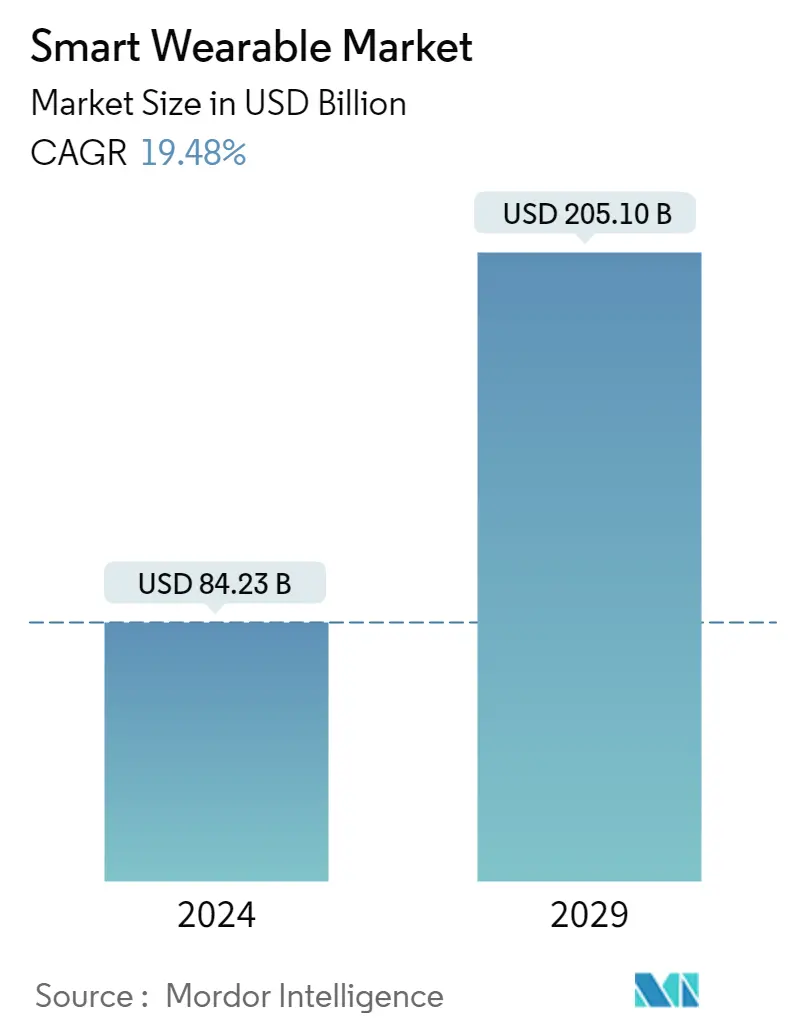
| Study Period | 2021 - 2029 |
| Market Size (2024) | USD 84.23 Billion |
| Market Size (2029) | USD 205.10 Billion |
| CAGR (2024 - 2029) | 19.48 % |
| Fastest Growing Market | Asia Pacific |
| Largest Market | North America |
Major Players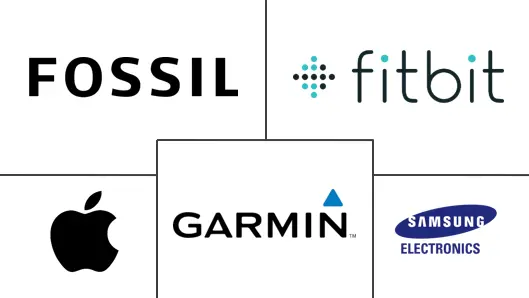
*Disclaimer: Major Players sorted in no particular order |
Smart Wearables Market Analysis
The Smart Wearable Market size is estimated at USD 84.23 billion in 2024, and is expected to reach USD 205.10 billion by 2029, growing at a CAGR of 19.48% during the forecast period (2024-2029).
Research advancements have led to increased innovation in recent years and are instrumental in driving the demand for the wearable market. It also led to new product categories like smart fabrics and hearables, which incorporate high-end technology and design in daily living. Lately, the focus is to provide an aesthetic design to devices to attract customers.
- Wearable technology, an emerging trend, integrates electronics into daily activities and addresses the changing lifestyles with the ability to wear on any body part. Factors such as the ability to connect to the internet and data exchange options between a network and a device are leading to the wearable technology trend.
- Wearables have gained significant traction owing to the boom in the fitness trend across consumers. According to Cisco Systems, connected wearable devices are expected to increase from 593 million in 2018 to 1,105 million this year. The smartwatch category is experiencing a rise, owing to additional features, like the brand that suits the everyday lifestyle. Strong brands, such as Apple and Fossil, are keeping the pricing consistent with the price bands of traditional watches to maintain their revenues. With Google's WearOS, many other premium watchmakers, such as TAG and Armani, have entered the segment.
- The rising penetration rates of urbanization in various parts of the world have driven the demand for advanced, aesthetically appealing products to better serve consumers' requirements, such as multiple features in one device and time schedules. Moreover, the vast millennial population across the globe was quick to adopt smartwatches, owing to the increased spending ability on their regular work hours tracking and luxury standards.
- Hearables are gaining traction with the increasing acceptance of smart assistants. Companies like Bragi, Google, Apple, Jabra, Samsung, and Sony have been actively contributing to the growth of this segment.
- The COVID-19 outbreak and the lockdown restrictions across the world have affected industrial activities around the globe. The electronics industry is hit severely with a significant influence on its supply chain and production facilities. Production reached a standstill in China and Taiwan during February and March, influencing various OEMs worldwide.
Smart Wearables Market Trends
This section covers the major market trends shaping the Smart Wearable Market according to our research experts:
Head-Mounted Displays is Expected to Drive the Market Demand
- A head-mounted display is a device with a small display optic in front of one (monocular HMD) or each eye (binocular HMD) and worn on the head or as part of a helmet. These are primarily used for various purposes, including gaming, aviation, engineering, and medicine. Heads-up displays do not block the user's vision but superimpose the image on the user's view of the real world. An emerging form of a heads-up display is a retinal display that projects a picture directly on the sensitive part of the retina. However, the image appears on a screen at the user's ideal viewing distance. Still, there is no actual screen in front of the user. It includes special optics, such as modified eyeglasses that reflect the image into the user's eye. Some Head-mounted displays have motion sensors to determine direction and movement or as the interface to an immersive virtual reality application.
- The display is an integral part of the HMDs and generally is categorized into Virtual Reality (VR) and Augmented Reality (AR) devices. AR devices have a transparent display and digital information superimposed onto real-life objects. These HMDs are known as Optical head-mounted displays or OHMDs. In a VR device, the display is not transparent, and only virtual information and images are present in front of the wearer's eyes.
- Based on the functionality, processing HMDs are further categorized into Slide-on HMD, Discrete HMD, and Integrated HMD. The Slide-on HMD is the most cost-effective and accessible form of VR and consists of a smartphone holder, lenses, and some primary input. A smartphone is placed into the slide-on HMD, and the entire device is played upon the user's eyes to create the VR experience. Thus, it utilizes the smartphone for display, processing, and rotational tracking. However, some use their own IMUs instead of relying on smartphones. For instance, Samsung Gear VR utilizes its built-in IMUs.
- Discrete HMDs have a display, lenses, rotational tracking, positional tracking, audio, and advanced input, aside from processing. Thus, it requires connections to personal computers for processing. It delivers the best VR experience but is less mobile than slide-on and integrated HMD. It is also known as Tethered HMD, and some of them are Oculus Rift, HTC Vive, PlayStation VR, etc.
- Integrated HMD is the most advanced and expensive HMD and OHMD. It is an independent computing device that delivers VR or AR experiences without external hardware, such as a PC or smartphone. It contains a display, processors, and a camera and can display stereoscopic 3D images, perform complex tracking, and utilize advanced input methods. Currently, most integrated HMDs are AR OHMDs with high price points and target only business professionals. The most popular integrated HMD are Microsoft HoloLens, Google Glass, Magic Leap, etc.
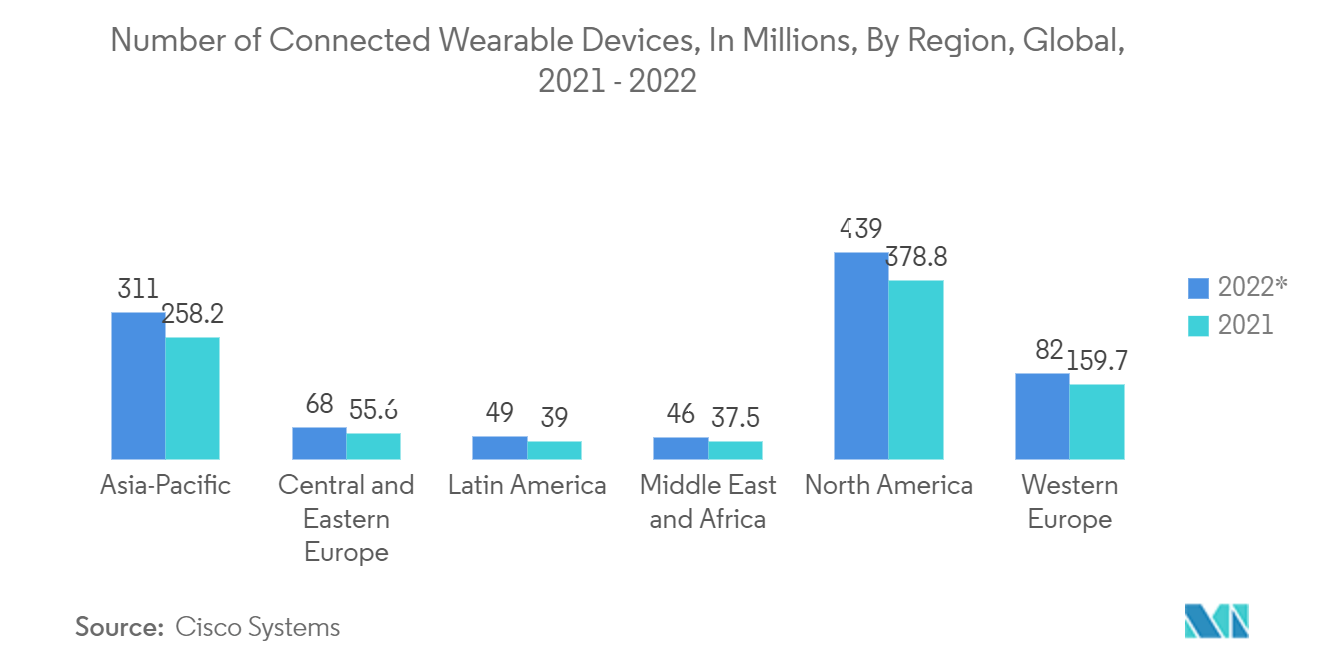
Asia-Pacific to Witness the Fastest Growth Rate
- The Asia-Pacific region is expected to witness the highest growth in the smart wearable market during the forecast period. The growing electronics industry and a rapid rise in disposable income in the region are driving the smart wearable market.
- In China, the wearables market had taken a different shape, fuelled partly by the purchases of growing affluent consumers. For instance, a recent report by a government think tank in China stated approximately 80% of the smart wearable devices in the world are manufactured in the southeastern Chinese port city and manufacturing hub. According to the China Center for Information Industry Development report, Shenzhen, the base camp of many Chinese tech giants, is the most extensive R&D (research and development) and production center for smart wearables.
- In March this year, According to the Indian Cellular and Electronics Association (ICEA), the PMP rationalized the inverted duty structure to produce smart wearables. After boosting local manufacturing of mobile phones and laptop/tablet computers, the Indian government launched a new Phased Manufacturing Programme(PMP) to create wrist wearable gadgets, hearable devices, and electronic smart meters.
- Moreover, increasing awareness regarding fitness, technological advancements, and the availability of high-speed Internet connectivity are the major factors propelling smart wearable market growth in the country.
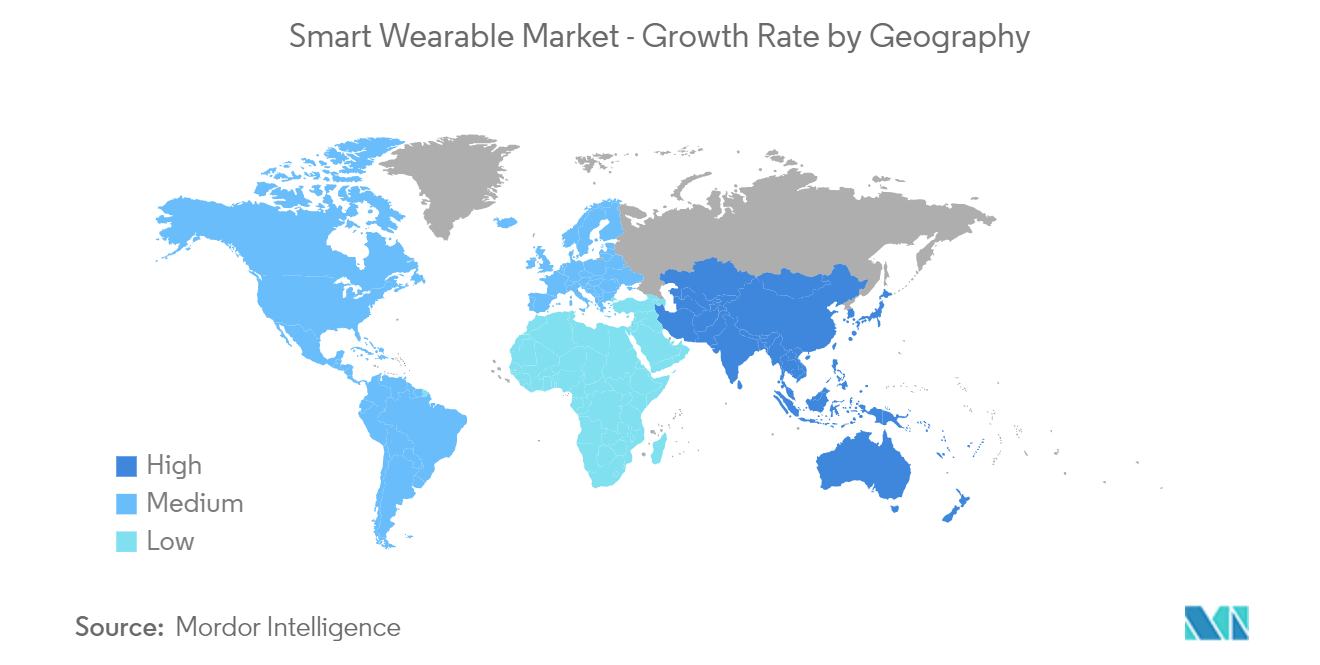
Smart Wearables Industry Overview
The smart wearable market is highly competitive and gained a competitive edge in recent years. Additionally, the players have gained a competitive advantage in this fast-growing market, mainly catering to the demand of the millennial generation population.
- September 2022 - U&i announced the launch of three premium wearables for an active lifestyle. In real-time, the smartwatch also features Sports Modes that can sense multiple body activities, such as walking, running, jogging, etc., to help users stay fit and active.
- May 2022 - Vuzix Corporation announced signing an agreement with Atomistic SAS (Atomistic), an mLED(micro-Light Emitting Diode) display solutions enterprise based in France. The agreement provides for the custom backplane design, an exclusive license of key mLEDtechnology, and the ability to acquire the enterprise, which depends upon achieving various technical phases. The Atomistic company will deliver a backplane on advanced node 300mm wafers, along with system-level support from Vuzix, intended to support upcoming mLEDs based upon its innovative material science and alternative LEDs from potential third-party suppliers. The mLEDswill be provided for AR glasses.
Smart Wearables Market Leaders
-
Apple Inc.
-
Fitbit Inc.
-
Fossil Group Inc.
-
Samsung Electronics Co., Ltd.
-
Garmin Ltd.
*Disclaimer: Major Players sorted in no particular order
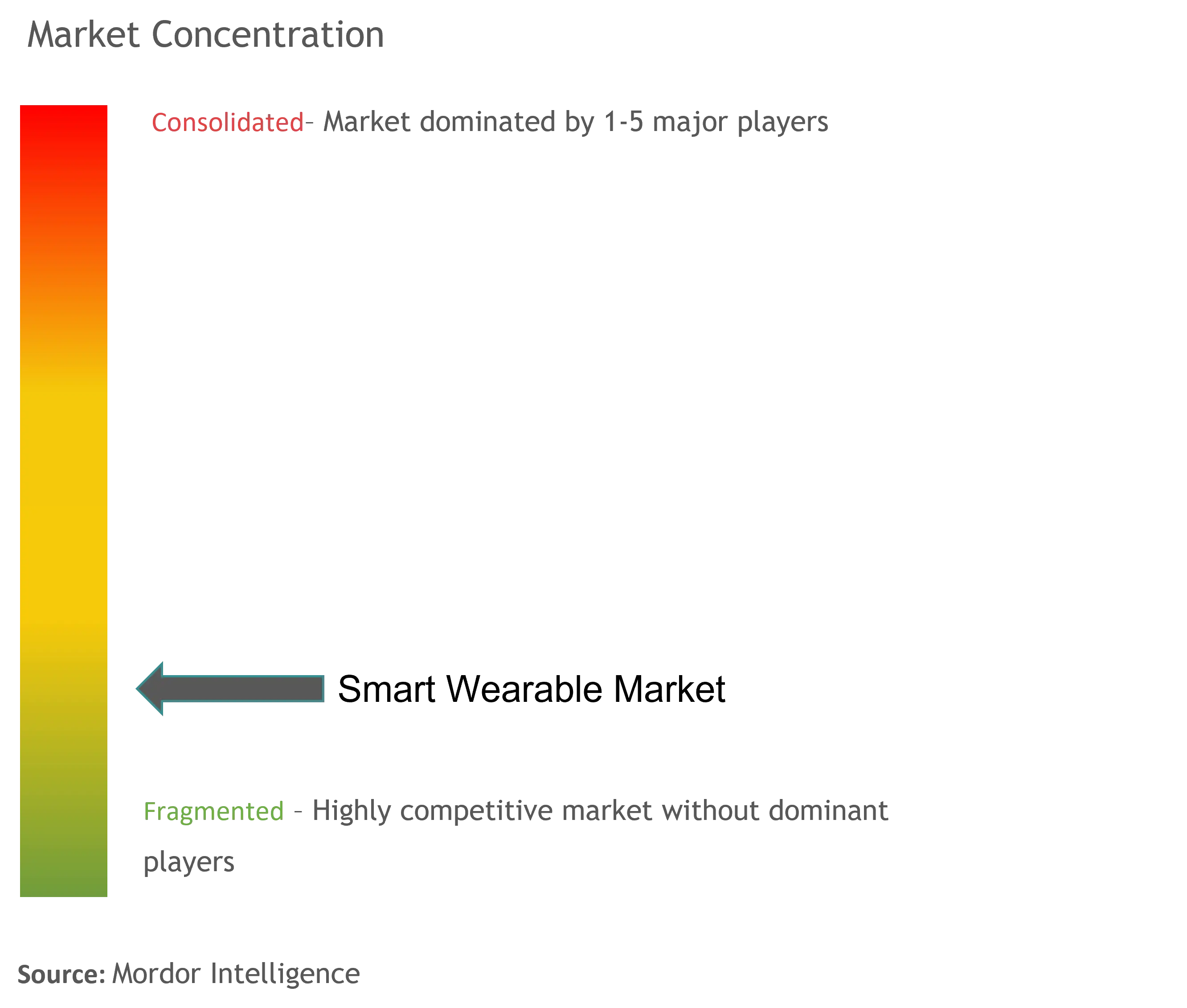
Smart Wearables Market News
- October 2022 - Garmin announced the launch of two new wearables, Venu SQ 2 and nu SQ 2 Music Edition, in the Indian market. Both smartwatches will be equipped with all-day fitness tracking, health monitoring, and connected features for all Indian consumers.
- February 2022 - Sleep Coaching, a new feature displaying animal icons and indicating the user's sleep style, is a significant update on Galaxy Watch 4 from Samsung Electronics Co., Ltd. It will provide a 4-5 week regimen to assist customers in improving their sleep quality. Samsung will also introduce a variety of new official watch bands for the Galaxy Watch 4, including fabric, link bracelet, and sport band options in new colors.
Smart Wearables Market Report - Table of Contents
1. INTRODUCTION
- 1.1 Study Assumptions and Market Definition
- 1.2 Scope of the Study
2. RESEARCH METHODOLOGY
3. EXECUTIVE SUMMARY
4. MARKET INSIGTHS
- 4.1 Market Overview
-
4.2 Industry Attractiveness - Porter's Five Forces Analysis
- 4.2.1 Bargaining Power of Suppliers
- 4.2.2 Bargaining Power of Buyers
- 4.2.3 Threat of New Entrants
- 4.2.4 Threat of Substitute Products
- 4.2.5 Intensity of Competitive Rivalry
- 4.3 Value Chain Analysis
- 4.4 Assessment of Impact of COVID-19 on the Industry
5. MARKET DYNAMICS
-
5.1 Market Drivers
- 5.1.1 Incremental Technological Advancements Aiding the Market Growth
-
5.2 Market Restraints
- 5.2.1 High Cost and Data Security Concerns
6. MARKET SEGMENTATION
-
6.1 By Product
- 6.1.1 Smartwatches
- 6.1.2 Head-mounted Displays
- 6.1.3 Smart Clothing
- 6.1.4 Ear Worn
- 6.1.5 Fitness Trackers
- 6.1.6 Body-worn Camera
- 6.1.7 Exoskeleton
- 6.1.8 Medical Devices
-
6.2 By Geography
- 6.2.1 North America
- 6.2.1.1 United States
- 6.2.1.2 Canada
- 6.2.2 Europe
- 6.2.2.1 United Kingdom
- 6.2.2.2 Germany
- 6.2.2.3 France
- 6.2.2.4 Rest of Europe
- 6.2.3 Asia Pacific
- 6.2.3.1 China
- 6.2.3.2 Japan
- 6.2.3.3 India
- 6.2.3.4 South Korea
- 6.2.3.5 Rest of Asia Pacific
- 6.2.4 Latin America
- 6.2.5 Middle East and Africa
7. COMPETITIVE LANDSCAPE
-
7.1 Company Profiles
- 7.1.1 Ekso Bionics Holdings Inc.
- 7.1.2 Cyberdyne Inc.
- 7.1.3 Transcend Information Inc.
- 7.1.4 GoPro Inc.
- 7.1.5 Sensoria Inc.
- 7.1.6 AIQ Smart Clothing Inc.
- 7.1.7 Medtronic PLC
- 7.1.8 Withings
- 7.1.9 Huami Corporation
- 7.1.10 Omron Healthcare Inc.
- 7.1.11 Nuheara Limited
- 7.1.12 Bragi GmbH
- 7.1.13 Microsoft Corporation
- 7.1.14 Sony Corporation
- 7.1.15 Huawei Technologies Co. Ltd
- 7.1.16 Fitbit Inc.
- 7.1.17 Fossil Group Inc.
- 7.1.18 Garmin Ltd
- 7.1.19 Samsung Electronics Co. Ltd
- 7.1.20 Apple Inc.
- *List Not Exhaustive
8. INVESTMENT ANALYSIS
9. FUTURE OF THE MARKET
** Subject To AvailablitySmart Wearables Industry Segmentation
Wearable technology study tracks the various types of products currently being adopted, such as smartwatches, head-mounted displays, smart clothing, ear-worn, fitness trackers, body-worn camera, exoskeletons, and medical devices.
The Smart Wearable Market is segmented by product (smartwatch, head-mounted display, smart clothing, ear-worn, fitness tracker, body-worn camera, exoskeleton, and medical devices) and geography (North America, Europe, Asia Pacific, Latin America, and Middle East and Africa).
The market sizes and forecasts are in terms of value (USD million) for all the above segments.
| By Product | Smartwatches | |
| Head-mounted Displays | ||
| Smart Clothing | ||
| Ear Worn | ||
| Fitness Trackers | ||
| Body-worn Camera | ||
| Exoskeleton | ||
| Medical Devices | ||
| By Geography | North America | United States |
| Canada | ||
| By Geography | Europe | United Kingdom |
| Germany | ||
| France | ||
| Rest of Europe | ||
| By Geography | Asia Pacific | China |
| Japan | ||
| India | ||
| South Korea | ||
| Rest of Asia Pacific | ||
| By Geography | Latin America | |
| Middle East and Africa |
Smart Wearables Market Research FAQs
How big is the Smart Wearable Market?
The Smart Wearable Market size is expected to reach USD 84.23 billion in 2024 and grow at a CAGR of 19.48% to reach USD 205.10 billion by 2029.
What is the current Smart Wearable Market size?
In 2024, the Smart Wearable Market size is expected to reach USD 84.23 billion.
Who are the key players in Smart Wearable Market?
Apple Inc., Fitbit Inc., Fossil Group Inc., Samsung Electronics Co., Ltd. and Garmin Ltd. are the major companies operating in the Smart Wearable Market.
Which is the fastest growing region in Smart Wearable Market?
Asia Pacific is estimated to grow at the highest CAGR over the forecast period (2024-2029).
Which region has the biggest share in Smart Wearable Market?
In 2024, the North America accounts for the largest market share in Smart Wearable Market.
What years does this Smart Wearable Market cover, and what was the market size in 2023?
In 2023, the Smart Wearable Market size was estimated at USD 70.5 billion. The report covers the Smart Wearable Market historical market size for years: 2021, 2022 and 2023. The report also forecasts the Smart Wearable Market size for years: 2024, 2025, 2026, 2027, 2028 and 2029.
What are the major factors driving the Smart Wearables Industry?
The major factors driving the Smart Wearables Industry are a) Seamless pairing between smart wearables and smartphones enhancing functionality and user experience b) Increased consumer understanding of the health and lifestyle benefits offered by smart wearables
What are the key challenges faced by the Smart Wearables Market?
Key challenges faced by the Smart Wearables Market include: a) Data privacy concerns b) High product costs c) Limited battery life of wearable devices
Smart Wearables Industry Report
The global smart wearables market is experiencing significant growth, driven by the increasing adoption of innovative smart wearable technology products. These devices, including smartwatches, fitness trackers, head-mounted displays, and smart clothing, are revolutionizing how individuals monitor their health and interact with their surroundings. The market size is expanding, with segments like wristwear and headwear & eyewear benefiting from advancements in AI and AR technologies.
The market share is dominated by North America, although the Asia Pacific region is rapidly catching up due to technological advancements and greater consumer affordability. The global market is not only focused on consumer electronics but also sees substantial adoption in the healthcare sector for real-time monitoring capabilities. The market growth is fueled by the industry's ability to blend functionality with fashion, appealing to a broad audience.
Industry reports reveal that the market analysis covers various segments and geographies, providing detailed insights into market trends, market forecast, and market segmentation. These industry reports highlight the market value and market outlook, projecting a positive trajectory for the future of wearable technology.
The market leaders are driving innovation, contributing to the market review and market predictions that foresee continued expansion. Industry research and industry statistics support these findings, with industry information pointing to a robust market size and market data indicating strong industry sales.
The industry analysis and industry overview provide a comprehensive understanding of the market, while industry trends and industry outlook emphasize the dynamic nature of the sector. The report example and report pdf offered by research companies like Mordor Intelligence™ provide valuable insights into the market forecast and market review, ensuring stakeholders stay informed about the latest developments.
In conclusion, the smart wearables market is poised for sustained growth, with industry research and market predictions indicating a bright future. The combination of market data, industry reports, and market analysis underscores the market's potential, making it a key area of interest for both consumers and industry players.



